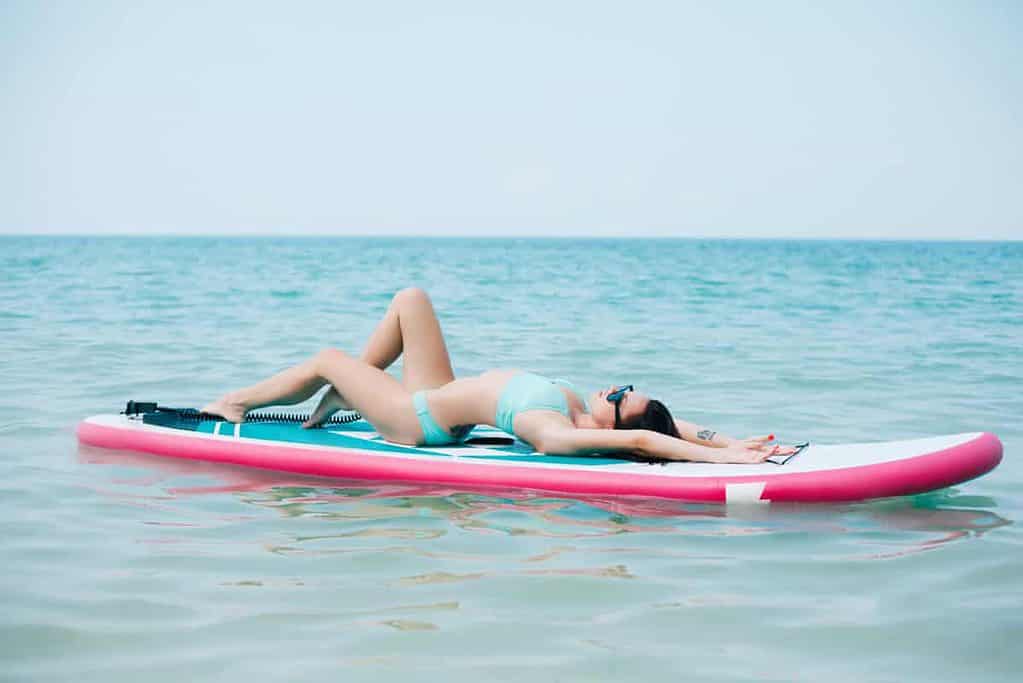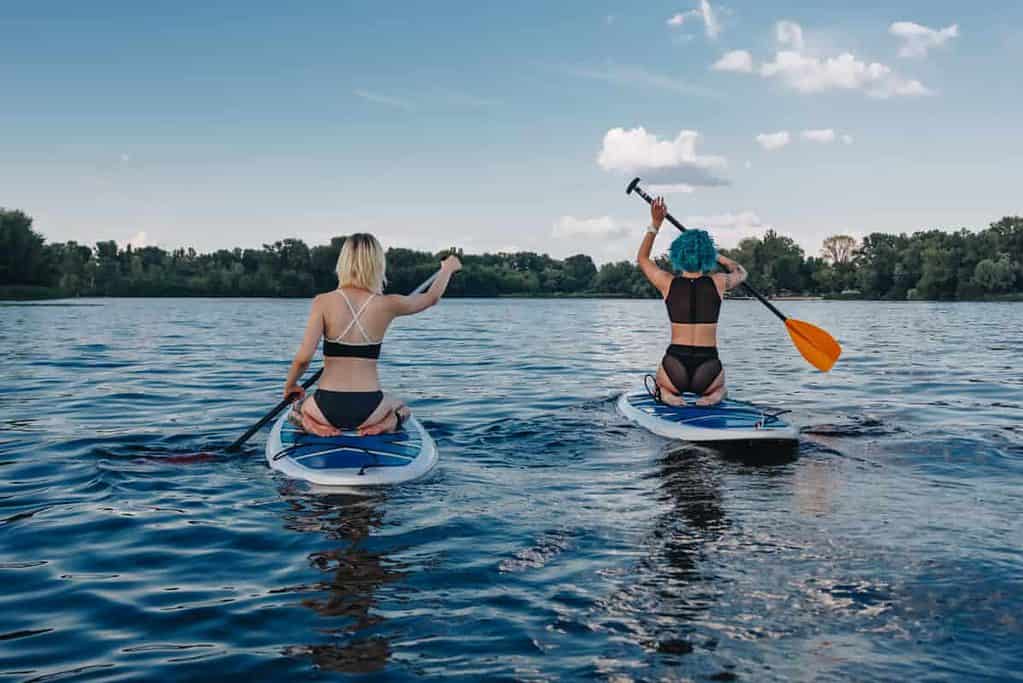
FRIENDLY FUN – Canoeing, kayaking, and stand up paddleboarding are great fun—just ask any paddler you find on the water. Paddling offers so much; quiet leisure, intense adrenaline, or a path to exploration and adventure. Paddling is a great way to access nature, experience reflective moments and to enjoy family and friends away from the distractions of life. Occasionally, conflicts arise between various boating groups because of craft size, education and training of the operators, maneuverability, geographic constraints, and the sheer numbers of recreational users on the waterways. Paddlers should be aware of a few “Rules of the Road” when sharing resources with other boat traffic. Importantly, keep a proper lookout, and remember to be courteous to other boaters.
Canoeing, Kayaking, Stand Up Paddle Boarding, and Rafting
Paddling refers to the group of watersports that require a paddle to propel and steer a vessel through and across the water. Traditionally, two sports have fallen in the category of paddling, that is canoeing and kayaking.
Be Aware of Your Surroundings
First and foremost, be aware of your surroundings. You may be the only craft on the water, or sharing the channel with a large container ship. Whatever the circumstance, your awareness of other traffic may make the sole difference in everyone’s safety. Paddlers do not travel as fast as motorized craft. If you see a powerboat, do not assume that you can pass ahead of it if traveling across its path. The safest way for paddle craft to cross the path of a powerboat is astern. Remember to cross other boats as a group instead of straggling across the river and blocking other traffic. In shared waterways, the more boaters watching for others, the safer everyone will be.
Big Boats, Bright Lights and Take Waves Head On.
Some busy waterways have “lanes of travel” similar to the Interstate highway system. Know the area you plan to paddle. If you are near commercial waterways, the navigation charts change often and you need a current set. The depth of the channel may limit deep-draft vessels. You, however, are mobile and agile. Make use of your ability to move out of the way. If you are not crossing the channel stay close to shore. Large stationary objects offer a margin of protection. At night, a white light must be shown toward oncoming traffic. Bright colors not only help keep track of fellow paddlers, but make you far easier to see if separated from your craft. If motorized craft are nearby, you are far less likely to capsize if you turn your bow into the wave and don’t take the wake broadside.
SEE and BE SEEN
- Wear bright, noticeable clothing
- Use reflective tape on your paddle blades
- Keep your whistle handy
- Any vessel less than 20 meters should not impede the passage of a larger ship, whether under power or not.
- Monitor Channels 13 & 16 on your VHF Radio
- At night and during low-light conditions, a white light must be shown toward oncoming traffic
Paddling Rules of the Road
Learn the channels in your area and what the buoy markers mean. While onboard and facing downstream or leaving a harbor, green lights indicate starboard (right) and red lights indicate port (left). When returning or heading upstream, red lights or buoys should be on your starboard side. Remember, “Red Right Returning.” The markers are for the larger craft so if you stay between the light or buoy and the shore, you are out of the way of any of the larger, faster craft and less likely to encounter wake and turbulence from commercial vessels. Since the events of September 11, 2001, recreational boating in the United States has changed. Now many harbors and waterways have security zones surrounding different resources. In ports and harbors, there are now restrictions on crafts within 100 yards of all U.S. Navy vessels. On local lakes and rivers, there may be restricted areas around bridge abutments, large dams and some shore based facilities, such as powerplants. Some jurisdictions also have law enforcement personnel stationed near drinking water reservoirs to protect against biological incidents.
Information provided in part by americancanoe.org

Paddling, Kayaking, Canoeing – Seven Golden Rules
Recreational boating is about having an enjoyable time while you’re on the water. And it’s always fun and games until someone get hurt or has a bad experience. No matter what kind of boating activity you participate in, these five “golden rules” will go a long way toward ensuring that your trips on the water end safely.
Always wear your life jacket.
70% of all boating deaths are drownings, and over 80% of all drowning victims were not wearing a life jacket. Wearing your jacket all the time you’re on the water is the most important thing you can do to ensure your safety. So why doesn’t everyone do it? Some say, “They’re uncomfortable.” Not so—modern jacket designs ensure there’s a comfortable fit for every body type. “I’m a good swimmer, I don’t need one.” Bottom line: there’s no good excuse.
Know your limits.
All too often, accidents occur when we boat in conditions that exceed our skill level. With any type of boating you undertake, start slow. Get some training, go with experienced boaters, visit your local boating equipment dealer, ask questions, practice. By all means, be honest with yourself. If the worst happens, can you handle it? Are you being urged by others to do something you know you shouldn’t attempt? Its all about having fun and Living to boat another day.
NO Alcohol
Alcohol out in the open and air and sun can have a different effect on you than at home or at a restaurant. Alcohol will cloud your judgment and slow your reactions down. Avoid taking alcohol with you, rather enjoy your time out on the water with your canoe, Kayak. It’s all about balance, and fun, alcohol will impair your coordination and balance that you need to control your canoe, kayak, or paddle board.
Dress for a swim
Water conducts heat 25 times more efficiently than air. Wear apparel that will minimize heat loss when you go in the drink. And yes, if you boat long enough you will go for an unplanned swim. The temperature doesn’t have to be freezing to be dangerous; spend very long unprotected in 60-degree water and you’ll be in trouble, Hypothermia is a danger any time of year. There are many areas in the country where the water never gets above 60 – degrees temperature.
Don’t boat alone.
There’s safety in numbers. If you get into trouble when you’re by yourself, you’re totally dependent on your own resources. New paddlers should paddle with someone more experienced, and gain that experience. If you’re with others, you’ve got their experiences to lean on. Having at minimum 3 in a group allows one person to stay with the person, while the 3rd goes for help. Going in a group, you can support, and encourage each other as well as be seen by other boaters easier. It is all about having a fun day out on the water.
Practice
Learn how to get out of, hang on to, right, and re-enter your capsized boat. Stay Low Learn how to enter and exit your boat safely and stay low in your boat when possible. Most paddlesport-related drownings are the result of capsizing. Keep Your Balance Don’t overload your boat. Then you plan on taking gear or passengers, distributing passengers, securing gear evenly and low, and leaving your dog on land. Pets are fun, and exciting but can add a level of danger out on the water as they can be unpredictable. Learn about Your Boat Consider taking a canoe or kayak safety class. Get out and practice near shore and shallow waters.
Bring backup – Go in Groups
If you’re boating where there’s cell service, bring your phone, waterproof of course. Purchase, and practice with, the safety gear designed for your type of water sport. Create a “boater’s kit,” with enough essentials to help you survive an unplanned night out. With careful planning, you can make the basic kit small enough to carry in a belt pouch or in your life jacket. It should include some basic first aid supplies, fire steel or waterproof matches, some fire starters, a space blanket, and a collapsible water container with some water purification tablets. As a whole, you should always have a knife and whistle with you. You can also pack a small dry bag in the boat with things like some warm clothes, high-energy snacks, a headlamp, some lightweight rope, and even possibly a hammock, this will get you off the ground.
Be in Command Know how to move your boat forward, back, and sideways, and how to stop using paddle strokes. Watch ahead for hazards like undercut rocks, bridge pilings, large branches and trees, big drop-offs, or other boats. Plan Ahead Know the water you’re paddling, plan your day of paddling, and file a “float plan” so that someone knows where to find you and when you plan to return.
Canoeing, Paddle Boarding, and Kayaking the goal is to have fun out on the water while doing it safely. Boat Often, Boat Safely

